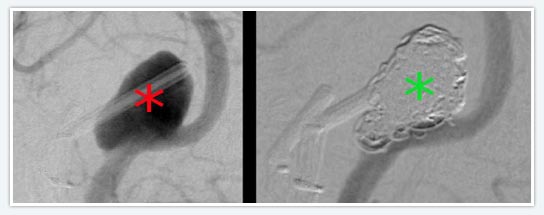Treatment of Brain Aneurysms:
Aneurysms of the brain are bulbous projections from brain arteries. Aneurysms cause symptoms when either they grow sufficiently to press upon brain structures or leak blood around the brain. Bleeding of aneurysms is also known as subarachnoid hemorrhage.
Subarachnoid hemorrhage can be devastating illness resulting in disability or death. Aneurysms which have bled or asymptomatic aneurysms which pose a significant risk over time are often treated by coil embolization. Coil embolization is the process of using angiogram techniques to fill an aneurysm with platinum coils. The body reacts to the presence of the coils by forming scar tissue in the aneurysm sealing the aneurysm from the flow of blood. The procedure takes a few hours and is performed under general anesthesia.
Aneurysms with a wide neck may require a stent to be placed across the opening of the aneurysm to trap coils in the aneurysm and prevent the coils from migrating into normal areas of the blood vessel. Placing a stent is also performed through a catheter and adds about one half an hour to the procedure. Patients receiving a stent as part of the coil embolization process usually take aspirin and Plavix (clopidigrel) for three months after treatment.
Patients undergoing routine aneurysm treatment by coil embolization should be prepared to spend two nights in the hospital after the procedure and (in most cases) plan to take two weeks off work.

Shown here is an aneurysm of the right internal carotid artery before (red *) and after (green *)
coil embolization by the neurointerventional team at Saint Luke's Hospital of Kansas City.

Enterprise intracranial stent used in the treatment of wide neck aneurysms.

A wide neck vertebral artery aneurysm (*) successfully treated by stenting and coiling. The stent,
not visible on the image, prevents the coil loops from blocking the normal portion of the blood vessel.
|











